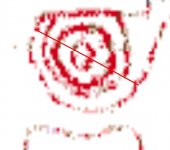A#1
Hero Member
I couldn't think of a better place to ask this.
I had a thought while overhearing a conversation about about FT3 and our impending doom
There's this place i know, out in never never land northern Michigan. A place usually frequented by ATV's, and that's about it. I used it as a shooting spot for uncontrolled fire.
I never really thought much of it till they were talking about craters, and it just popped in my head. It was followed by the thought, "Nature doesn't create straight lines, 90 degree angles......does it create nearly perfect, spherical holes in the dirt?"
I can't really get a picture of it at the moment, because I can't get into to the area for a while. The best I can do for now is crop it out of a topo map. It was pine forest until about 6-8 years ago when it was clear cut. The land around it is relatively flat +/-5 feet or so, and further out surrounded by glacially formed ridges. It's about 400 feet across, and 40 feet deep in a nice spherical bowl shape.
The straight line on the north side is an old railroad grade laid in 1892, and abandoned in 1932, it's now a sand road, not passable without a 4x4 and good sand tires. There is no reason for this hole to be man made, They had to bring fill to here (from the north side) to create the bed, and there are no major fill sites within a reasonable distance.
The line measure across it, was created with Google Earth to generate the elevation profile.
What do you think? Just natural oddity?
It would have required a nearly square on impact to make such a nice circle.
The only thing that has me thinking its natural is the lack of the dirt that would have filled it, but I don't know much about craters as to know how that would have been deposited onto the surrounding landscape. Would it appear as a visibly sharp ridge, or a hard to determine slow rise?


I had a thought while overhearing a conversation about about FT3 and our impending doom
There's this place i know, out in never never land northern Michigan. A place usually frequented by ATV's, and that's about it. I used it as a shooting spot for uncontrolled fire.
I never really thought much of it till they were talking about craters, and it just popped in my head. It was followed by the thought, "Nature doesn't create straight lines, 90 degree angles......does it create nearly perfect, spherical holes in the dirt?"
I can't really get a picture of it at the moment, because I can't get into to the area for a while. The best I can do for now is crop it out of a topo map. It was pine forest until about 6-8 years ago when it was clear cut. The land around it is relatively flat +/-5 feet or so, and further out surrounded by glacially formed ridges. It's about 400 feet across, and 40 feet deep in a nice spherical bowl shape.
The straight line on the north side is an old railroad grade laid in 1892, and abandoned in 1932, it's now a sand road, not passable without a 4x4 and good sand tires. There is no reason for this hole to be man made, They had to bring fill to here (from the north side) to create the bed, and there are no major fill sites within a reasonable distance.
The line measure across it, was created with Google Earth to generate the elevation profile.
What do you think? Just natural oddity?
It would have required a nearly square on impact to make such a nice circle.
The only thing that has me thinking its natural is the lack of the dirt that would have filled it, but I don't know much about craters as to know how that would have been deposited onto the surrounding landscape. Would it appear as a visibly sharp ridge, or a hard to determine slow rise?


Last edited:



